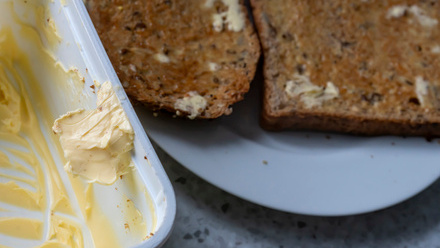Juliette Kellow RD looks at HEART UK's Ultimate Cholesterol Lowering Plan© .
As registered dietitians, we’re used to giving diet advice to lower cholesterol to patients in their mid to late 40s or older. But how many of us are aware of the growing evidence that cholesterol levels need to be tackled from a much younger age – from 25 years+ to reduce the length of time the body is exposed to the atherosclerotic effects of excess cholesterol?1
A number of recent studies investigating the lifetime exposure to elevated LDL and non-HDL cholesterol levels and risk of cardiovascular disease (CVD) have identified that it’s the cumulative life exposure to hyperlipidaemia that determines degree of risk, with greater risk of future CVD events associated with elevated LDL cholesterol levels in early life compared to similarly elevated LDL cholesterol levels in later life.1-3
High cholesterol levels in the younger age groups in the UK
How many of us are aware that 29% of 25–34-year-olds have cholesterol levels above 5mmo/L, rising to 45% of 35-44-year-olds and 57% of 45-54-year-olds?4
With this in mind HEART UK’s October National Cholesterol Month this year focused on getting younger adults to get to know their cholesterol levels, and as a case in point, highlighted the stories of three adults who shared their personal experiences of following the charity’s Ultimate Cholesterol Lowering Plan© (UCLP©) after discovering they had high cholesterol at a young age.
About the UCLP©
The UCLP© is one of HEART UK’s – the cholesterol charity – evidence-based dietary plans. The UCLP© was developed in 2011 in collaboration with HEART UK and leading health experts in diet and heart health including registered dietitians and GPs. The UCLP© is a pragmatic UK adaptation of the scientifically grounded Portfolio diet which has the potential to significantly lower LDL cholesterol, non- HDL cholesterol, apolipoprotein B, total cholesterol, triglycerides, systolic and diastolic blood pressure as well as C-reactive protein.5
The UCLP© is made up of three progressive steps.
Step one: focuses on motivational interviewing and helping the patient overcome their barriers and identifying their motivators for adapting dietary change.
Step two: focuses on a heart healthy foundation diet where replacement of saturated fats with unsaturated fats is of priority. This is then followed by improving intakes of plant over animal proteins, encouraging two weekly servings of fish (one of which to be oil-rich), increasing wholegrains and achieving 5-a-day. Which adaptations are taken on board and how many changes are made are tailored for each individual patient. Once Step two has been optimised, an optional step three can be introduced.
Step three: focuses on the addition of four specific foods which have been demonstrated to cumulative lower serum cholesterol levels beyond that seen from a heart healthy diet. These four foods are: oats, soya, nuts and foods fortified with plant stanols or sterols. Each food has been extensively investigated.6-10
Further scientific information on the UCLP© scientific background can be accessed here and practical information and multiple resources for consumers can be accessed at heartuk.org.uk/uclp.
Case studies
For 2022, HEART UK set out to identify free living case studies in their 30s and early 40s with elevated cholesterol levels who were willing to undertake the UCLP© under the supervision of a trained registered nutritionist. Social media was used to recruit individuals within this age range who were also looking to improve their current lifestyle. Individuals who came forward had a blood test to identify if they were hyperlipidaemic and able to follow the plant for a duration of up to 10 weeks. Three individuals were identified, a couple in their 30s and a 41-year-old female.
The interaction
The three individuals were regularly seen by the trained registered nutritionist in person and virtually. The registered nutritionists was trained and regularly liaised throughout the process with a registered dietitian involved with the development of the UCLP©. The registered nutritionists took the individuals through the three UCLP© steps, tailoring the advice to meet the motivational and practical needs of each individual.
The case studies undertook the UCLP© over a period of 8-10 weeks tackling one to two changes at any one time. For all case studies reducing saturated fats and replacing with unsaturated fats was of priority which was facilitated by including more plant proteins. Each step was explained to the individuals by the health professional. They were also provided with a hamper of UCLP© recommended foods including wholegrains, nuts, seeds, fruit, beans and lentils, soya and mycoprotein products as well as vouchers.
Baseline anthropometric and blood measures were taken and repeated at the end of their 8-10-week period on the diet.
The results
|
|
Agata |
Ross |
Beya |
|||
|
Measures |
Baseline |
9-weeks |
Baseline |
9-weeks |
Baseline |
10-weeks |
|
Actual age (years) |
39 |
39 |
33 |
33 |
41 |
42 |
|
NHS heart age (years) |
39 |
39 |
33 |
32 |
48 |
42 |
|
Weight (kg) |
61 |
60 |
117 |
114.3 |
76.6 |
68.0 |
|
Weigh change (kg) |
-1 |
-2.7 |
-8.6 |
|||
|
BMI |
21.6 |
21.3 |
34.9 |
34.1 |
28.1 |
24.9 |
|
Waist (cm) |
75 |
73 |
115 |
111 |
103 |
86 |
|
Waist circum. Reduction (cm) |
-2 |
-4 |
-17 |
|||
|
Total cholesterol (mmol/L) normal <5mmol/L* |
6.0 |
4.5 |
6.8 |
5.4 |
6.4 |
4.6 |
|
HDL-C (mmol/L) above 1.0 for a man* above 1.2 for a woman* |
1.53 |
1.24 |
1.27 |
1.2 |
0.99 |
1.1 |
|
LDL-C (mmol/L) Normal <3mmol/L* |
4.1 |
2.7 |
4.6 |
3.2 |
4.7 |
2.9 |
|
Non-HDL (mmol/L) Normal <4mmol/L* |
4.47 |
3.26 |
5.53 |
4.2 |
5.41 |
--- |
|
Triglycerides Normal<2.3mmol/L non-fasting* |
0.87 |
1.17 |
1.98 |
2.25 |
1.51 |
1.3 |
|
TC:HDL >6 = high risk* <6 = better* |
3.92:1 |
3.63:1 |
5.35:1 |
4.5:1 |
6.46:1 |
4.2:1 |
* normal levels recommended for healthy adults without any other risk factors to heart disease
The case studies tell their stories
Mum of three Beya, 41, is married with three children, aged 9, 13 and 17. She recently graduated from university and has a new job as a civil servant for the Scottish Government.
“Finding out I had high cholesterol and an NHS heart age of 48 – seven years older than my actual age – was a shock. But looking back, I realised my exercise and eating patterns had changed, and not for the better. For a few years, I’d been juggling family life with studying and had been skipping breakfast and lunch, regularly eating sugary snacks, fried foods and pastries, and taking less exercise. I’d gained weight and was the heaviest I’d ever been at 76.6kg with a BMI of 28 and a waist of 103cm.
“Having graduated and started a new job, it felt the right time to make positive changes to my diet. I liked the idea of the UCLP© as I already enjoyed fruit, veg, beans, lentils and fish. It was also important to follow a plan that included meals my husband and children would enjoy – I didn’t want to cook separate meals for myself.
“I began by tackling the meal skipping. Breakfast was a blank canvas so the perfect time to add some of the ULCP© foods. I enjoyed overnight oats made with soya alternatives to milk and yogurt, topped with berries, dried fruits, nuts or seeds. Lunch was soup and a sandwich or salad with plant protein. Once the UCLP© was explained to me, I realised that reducing my intake of saturated fat, as part of a varied balanced diet and lifestyle, was central to managing my cholesterol levels.
“I started looking at the saturated fat content on food labels and made simple changes in cooking, such as using vegetable oils instead of butter and soya alternatives in place of cream in curries. I searched online for low saturated fat recipes and tried different plant foods and alternatives to meat. Quorn Mince and bean tacos, lentil dhal, and tofu stir fry with cashews became popular family dinners. Before being advised from m registered nutritionist, I hadn’t realised there were so many plant and alternative proteins, all much lower in saturated fat and realising that they were just as good for building and maintaining muscle as meat. I expected to crave a steak, but I didn’t miss meat at all.
“It was initially hard to avoid sweet things, especially my daughter’s home baking, but we used healthier fats and added oats and fruit.
“I built more exercise into my week, walking 10,000 steps a day.”
The results
“These diet and exercise changes meant in ten weeks, I lost an amazing 17cm from my waist and 8.6kg. My BMI has dropped from a high 28.1 to 24.9 which is very close to the recommended normal range of 19-24. What I am most thrilled about is my cholesterol results which after just ten weeks on the UCLP© have all come down within normal ranges! My total cholesterol came down from a high 6.4mmol/L to within normal levels of 4.6mmol/L, my bad (LDL) cholesterol has also dropped from a high 4.7mmol/L to a normal level of 2.9mmol/L. All these improvements means my NHS Heart Age reflects my actual age of 42 years!
“Following this plan didn’t feel like being on a diet. It helped me make sustainable changes, made me mindful about my food choices and encouraged an enjoyable relationship with food. It helped that my husband and children were supportive and happy to try new foods and meals – they’ve all benefited from eating more fruit, veg and plant and alternative protein foods and less meat and full-fat dairy, too. I found the UCLP© unrestrictive and easy to fit around busy schedules that include working, studying and family life.”
Couple Ross, 33 and Agata, 39, work in engineering science. Neither of them realised they could have high cholesterol in their 30s.
Agata says: “I couldn’t believe it when I discovered my cholesterol was high. I was only in my 30s, was a healthy weight and didn’t eat much meat or dairy. But when I was studying for a PhD my usual healthy lifestyle had taken a hit. Working from home meant my cycle to work stopped and I found it harder to fit in regular activity. Plus, pastries, sugary snacks, butter and takeaways had crept into my mainly plant-based diet. Ross was also shocked to discover his cholesterol was high. Getting our results was a lightbulb moment – we realised we needed a lifestyle overhaul.
“The ULCP© was really an extension of my existing diet but with vegetable oils and spreads instead of butter, fewer sugary snacks and more home-cooked meals. It highlighted the importance of keeping my saturated fat intakes down whilst following an overall varied balanced diet and lifestyle. It also opened my eyes to a much wider range of plant foods and alternative proteins, that were low in saturated fat. I already used soya alternatives to milk and yogurt, and Quorn Mince, but Ross and I tried new ingredients such as smoked and marinated tofu, tempeh, Quorn Fillets and Pieces, falafel and different beans and lentils. I also spread protein-rich foods across my day rather than having them in just one meal. Now, my overall diet feels more balanced.
“I also worked on my fitness. I did yoga every day, focussed on increasing my steps and included a cycle or longer walk at the weekend.
“These lifestyle changes worked. After nine weeks, my total cholesterol dropped by 25% from 6.5mmol/L to 4.5mmol/L and my LDL (bad) cholesterol reduced a massive 34% from 4.1mmol/L to 2.7mmol/L. Both are now in the normal range.
“I’m glad I got my cholesterol checked in my 30s and adjusted my diet to manage it. I’d recommend any of my friends or family get theirs checked too, even if they think they eat well and exercise regularly.”
Ross says: “Thinking about managing my cholesterol levels had never been on my radar until I received the shocking news that my cholesterol levels were high. I’m only 33 and didn’t even realise high cholesterol could damage my heart! I was cycling to work and going to the gym a few times a week so thought I was fit. But looking back, I had lost focus on exercising and was eating unhealthily. Though Agata ate a mostly plant-based diet, I didn’t eat much fruit and veg, ate meat most days, and enjoyed chocolate, pastries and cheese – all foods high in saturated fat. I knew I’d gained a lot of weight in the past few years and, with my BMI pushing 35 in the summer, knew it was time for change.
“First up was starting my day with a breakfast low in saturated fat and higher in protein, so in came porridge with fruit and a soya alternative to milk. I added a lot more fruit and veg to the rest of my day, too – lunch would be a vegetable or bean soup with a sandwich, or a salad with plant or alternative protein. I think I ate more fruit and veg in two months than I had in two years!
“I decided to cut out meat entirely and eat less cheese, which was easier than I expected. Instead, Agata and I included a few portions of fish and some egg-based dishes each week as well as lots of different soya foods and drinks, Quorn mycoprotein and different beans, lentils and peas. Despite some big changes, I didn’t feel my diet was restricted.
“I got back on track with my fitness, too. On top of my existing activity, I incorporated a weight training session at the weekend. Initially, I was concerned without eating meat I’d lack enough protein to build and maintain muscle, but I was surprised to discover plant and alternative proteins such as soya alternatives to milk and yogurt, beans, nuts and Quorn mycoprotein were an easy and versatile way to achieve this, whilst keeping saturated fat intakes down.
“In nine weeks, I had brilliant results. My total cholesterol plummeted from a high of 6.8mmol/L to a much lower 5.4mmol/L – a 20% drop bringing me much closer to the target of below 5mmol/L. My LDL (bad) cholesterol also fell by 30% from 4.6mmol/L to 3.2mmol/L, again, almost reaching the target of below 3mmol/L. I’ve also lost 2.7kg and 4cm from my waist.
“I’m really surprised by my cholesterol results over this short time on a plan that was really no extra effort to follow. I’m going to keep on the UCLP© for my own health and for the environment.”
References
- Brunner FJ, Waldeyer C, Ojeda F, et al. Application of non-HDL cholesterol for population-based cardiovascular risk stratification: results from the Multinational Cardiovascular Risk Consortium. Lancet 2019;394(10215):2173-2183. doi:https://doi.org/10.1016/S0140-6736(19)32519-X
- Domanski MJ, Tian X, Wu CO, et al. Time course of LDL cholesterol exposure and cardiovascular disease event risk. J Am Coll Cardiol. 2020;76:1507-1516.
- Shapiro MD, Bhatt DL. “Cholesterol-years” for ASCVD risk prediction and treatment. J Am Coll Cardiol. 2020;76:1517-1520.
- British Heart Foundation. Heart & circulatory disease statistics 2022 (Compendium). Chapter 5 – risk factors. BHF 2022. Available at: https://www.bhf.org.uk/what-we-do/our-research/heart-statistics/heart-statistics-publications/cardiovascular-disease-statistics-2022
- Chiavaroli L, Nishi SK, Khan TA, et al. Portfolio dietary pattern and cardiovascular disease: a systematic review and meta-analysis of controlled trials. Prog Cardiovasc Dis. 2018;61(1):43–53. doi:10.1016/j.pcad.2018.05.004.
- COMMISSION REGULATION (EU) No 686/2014 of 20 June 2014 amending Regulations (EC) No 983/2009 and (EU) No 384/2010 as regards the conditions of use of certain health claims related to the lowering effect of plant sterols and plant stanols on blood LDL-cholesterol. OJ. 2014;L 182:27-30.
- COMMISSION REGULATION (EU) No 1160/2011 of 14 November 2011 on the authorisation and refusal of authorisation of certain health claims made on foods and referring to the reduction of disease risk: Oat beta-glucan. OJ. 2011;L 296:28.
- COMMISSION REGULATION (EU) No 1048/2012 of 8 November 2012 on the authorisation of a health claim made on foods and referring to the reduction of disease risk. Barley beta-glucan. OJ. 2012;L 310:40.
- Jenkins DJA, Mirrahimi A, Srichaikul K et al. Soy protein reduces serum cholesterol by both intrinsic and food displacement mechanisms. J Nutr. 2010;140(12):2302S-11S.
- Kim Y, Keogh J, Clifton P. Nuts and Cardio-Metabolic Disease: A Review of Meta-Analyses. Nutrients. 2018;10(12):1935. doi: 10.3390/nu10121935




